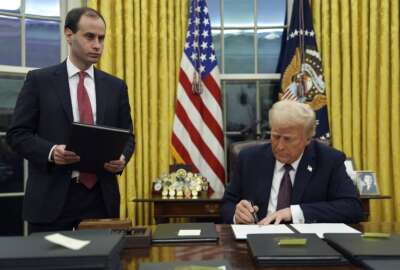Rehired annuitants help bridge agency skills gaps, but are they enough?
Agencies\' succession and next-generation training plans are unfocused, thanks to hiring freezes and budget cuts. Mission-critical projects pop up, but departments...
wfedstaff | June 4, 2015 7:59 pm
By Nicole Ogrysko
Federal News Radio
When Tom Bianco retired in 2013 from the Social Security Administration as a program manager for the agency’s major accounting system, he left with 37 years of government experience.
Close to the time he left, SSA placed credit-card swipes and check scanners in all of its field offices. The agency asked Bianco to stay on as a reemployed annuitant.
“We had lost a lot of people through attrition here, and the writing was on the wall that they were going to have a tough time implementing this,” Bianco told Federal News Radio as part of our special report, The Reverse Retirement Wave. “So they asked me to stay on and implement this project and see it through.”
The Social Security Administration is not the only agency that finds itself in this situation all too often. Hiring freezes and budget cuts mean agency succession planning is unfocused. Departments lack the workforce expertise to see new mission-critical projects through when long-time federal employees retire.
Though there is some evidence that agencies are turning to reemployed annuitants like Bianco for help, statistics on how often agencies use the program in the spirit and intent Congress first envisioned it are elusive. The Office of Personnel Management said it does not collect this information governmentwide.
An amendment to the 2015 National Defense Authorization Act allows agencies to rehire retirees without special permission from OPM. Congress extended that authority last year, but reemployed annuitants can’t make up more than 2.5 percent of an agency’s workforce.
While the expected retirement “tsunami” hasn’t landed quite yet, there has been a slight uptick in long-time federal employees leaving in recent years.
Ideally, agencies that bring in new employees toward the beginning or middle of their careers wouldn’t need to rehire former employees, said John Palguta, vice president for policy at the Partnership for Public Service.
“What has happened during sequestration, a lot of agencies froze hiring or put a semi-freeze on hiring,” he said. “Over a period of time — two or three years — you start getting things out of balance. You have people leaving. You haven’t brought in new people, and that puts a strain on agencies.”
Greater reliance on annuitants
If agencies can’t solely rely on new hires to complete mission-critical tasks, they often turn to reemployed annuitants to help bridge the gap.
Part of Bianco’s job now includes mentoring and training his younger colleagues, many of whom have little background in project management. He said there’s a wide range in age and experience at the Social Security Administration.
“We seem to have a mix of employees where many, many of them — like me — are nearing retirement age or ready to retire,” Bianco said. “There’s this other group that’s much younger — maybe in their 20s and 30s. And it seems like there aren’t a whole lot in between that. We’re in that peculiar spot in order to maintain continuity [where] we really need folks who have the experience to train others so they can carry on.”
Georgia Hubert also returned to government as a reemployed annuitant to lend her expertise. She retired in 2011 as a director of federal assistance at the State Department, where she left with more than 39 years of federal experience.
Like Bianco, Hubert said her colleagues have either 40 years of government experience or are just a few years out of college. Part of her job now, she said, is training them on what to look for in future contracts and grants.
“Most agencies right now, they’re all up against that hiring ceiling,” she said. “We’re bringing 40 years’ worth of experience in for these positions. Nobody’s going to come out of college with that much knowledge of what we do.”
But when it comes to filling that knowledge gap, agencies could do better.
Federal News Radio surveyed nearly 1,500 current and retired federal employees on retirement trends in the federal workforce over the course of two weeks. Of the retirees, 62 percent said they did not train a new employee before leaving government, while nearly 38 percent said they did help with some kind of training.
“We seldom got new employees,” wrote one respondent. “We had been severely understaffed for years. It was difficult to train in areas where we lacked expertise.”
Several respondents said their agencies’ training opportunities had shrunk along with their budgets.
“[I] was very much involved in mentoring programs and had received positive feedback that what I was doing was worthy,” another wrote. “Funding cut this short.”
It’s unclear how many agencies are bringing back employees such as Hubert and Bianco.
One of the few data points comes from SSA. Last June, the House Ways and Means Subcommittee on Social Security asked SSA for a full review of its reemployed annuitant program. The agency’s Office of Inspector General released its findings in January.
According to the report, SSA had 1,185 reemployed annuitants as of November 2014, including 985, or 1.62 percent of SSA’s 60,920 full-time employees, who were annuitants with dual compensation waivers. Since 2012, full-time annuitants have represented more than 1 percent of the agency’s workforce.
“Over the next few years, SSA believes its use of reemployed annuitants should return to less than 1 percent of the full-time permanent workforce, in line with its historical trends,” the report said. “However, this assumption is subject to change because of budget cuts. SSA noted that new hires increase its need for reemployed annuitants and cannot be fully seen.”
The IG’s report stated SSA planned to hire 6,000 new employees in 2014. But the agency said it cannot solely rely on new employees to fulfill all of its mission requirements.
“SSA reported it would take two years for new hires to complete the formal training, on-the-job proficiency reviews and technical mentoring necessary to ensure accuracy and the ability work independently,” the IG said. “Therefore, SSA anticipates needing approximately 1,150 reemployed annuitants for the next two years to train and mentor these new employees while also managing its workloads.”
Annuitants find their work meaningful
The desire to mentor and train the next generation, in part, brought Hubert, Bianco and others back to government for a second tour of duty.
When Hubert first retired at age 56, she said, it was too young for her to stop work altogether. After eight months of retirement, she returned to the State Department as a management inspector for the Office of Inspector General. Hubert said the chance to travel and do meaningful work for Embassy Baghdad and Kabul, was like “Paris in the spring” for her.
“I had been in the same office since 1999 and was working those 12 to 14-hour days supervising and just decided it was time for me to go,” she said. “I wasn’t going to go any higher financially, grade-wise. It just seemed like a good opportunity to go. So I retired looking for some other work and when the OIG called me, it just sounded very rewarding.”
Bianco is one of the 514 reemployed annuitants SSA hired in 2013, the most the agency has hired in the past five years. He said he didn’t want to leave initially, but it made more sense financially to retire from the agency and help his wife, who runs a small business. But the work, Bianco said, is meaningful.
“I find this, even as a reemployed annuitant, very rewarding,” he said. “We’re actually getting things done.”
For the annuitants who receive a dual compensation waiver rather than a salary offset, there are financial benefits as well. Hubert said she was looking for a higher salary with a government contractor after retirement, but she chose to return to the State Department.
“Yes, I’m a double dipper, but if I was looking for the big bucks I would have gone with [one of] the two contractors,” she said. “I called them back and they even offered me more money. [I told them,] ‘I’m going to go to the OIG and I’m going to make a difference.'”
But even if long-time federal employees find their work rewarding enough to return to government, they won’t stay forever.
Once she finishes her last inspection, Hubert said she’ll reach 3,120 hours — the maximum number she can complete during her reemployment — and will leave the State Department to look after family members.
Bianco said he will likely stay with SSA until 2016, and he wonders how much longer many of his colleagues will stay, too.
“I’ve been reading in the news about folks in Congress wanting to cut benefits left and right,” he said. “For a lot of folks nearing retirement age … they’re going to end up forcing them out, basically. I don’t know what that’s going to do to federal government as a whole, but it will certainly leave a void.”
Though federal employees aren’t yet leaving government in droves, it doesn’t mean agencies aren’t struggling, the Partnership for Public Service’s Palguta said.
“If you’ve had good, succession-planned people ready to take over, retirements are not a problem,” Palguta said. “But if you’re standing in the water and if the water’s up to your nose, you don’t need a tsunami. A gentle wave is enough to put you under.”
MORE FROM THE SPECIAL REPORT, THE REVERSE RETIREMENT WAVE:
Part 1: Feds choose to stay longer, creating new retirement bubble
Part 3: Mentoring helps young feds answer the question, ‘What’s next?’
Part 4: Feds ride the money, benefits wave longer than expected
Part 5: Recruiting, retention key to bucking federal retirement trends
Part 6: Military-style personnel system could smooth path to next-generation workforce
Part 7: Six signs of hope for the federal workforce of the future
Commentary: Time to start planning new retirement reality
Copyright © 2025 Federal News Network. All rights reserved. This website is not intended for users located within the European Economic Area.





